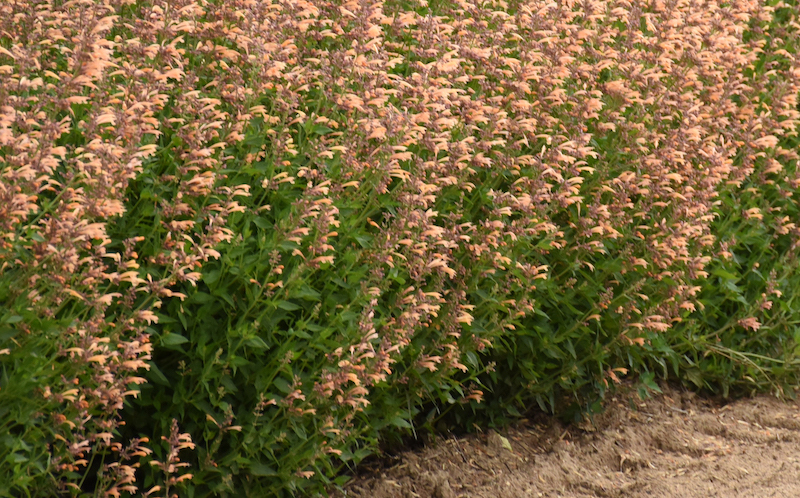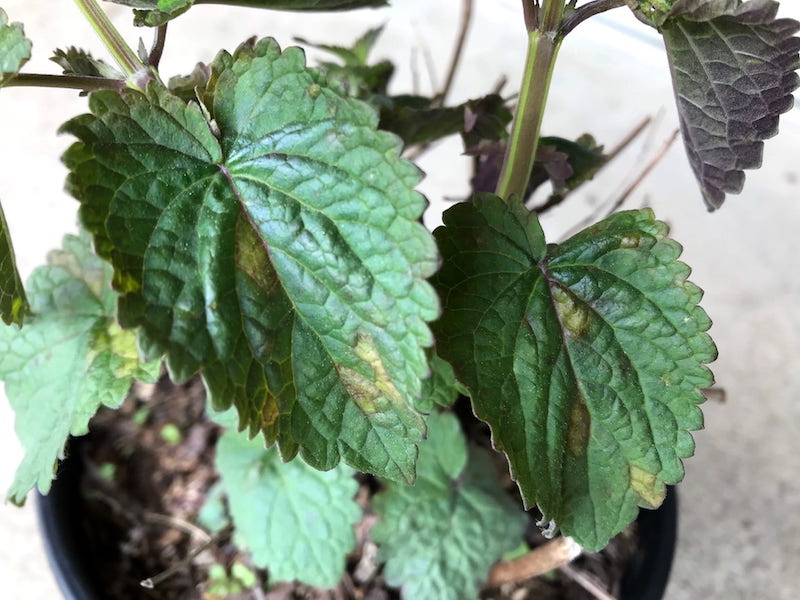The herbaceous perennial Agastache is perfect for adding to a pollinator garden, an herb border, or a cottage garden scheme. The plant is easy to grow, relatively low maintenance, and one of the better behaved plants in the mint (Lamiaceae) family. Diseases are generally not an issue for Agastache. Only a handful of fungal diseases are likely to infect your plants, and all of them are easily controlled using organic and sustainable gardening techniques.

Downy Mildew
Downy Mildew is a fungal disease that thrives in damp conditions and during cool temperatures like spring and fall weather. This disease is more likely to affect tender seedlings or new growth early in the spring. The fungal spores are easily transmitted to other parts of the plant through water, air, contaminated tools, or a person’s hands. Early detection of Downy MIldew is important for control. If large parts of a plant are affected, the only option for treatment may be to dispose of the plant altogether.
Identifying Downy Mildew
The first signs of Downy Mildew are purple or dark marks on the upper side of an affected leaf. As the disease progresses, the leaf undersides start to develop a gray or whitish fuzz from mildew spores. The foliage will die off as the spores mature. Spores that fall to the ground can overwinter in leaf litter, mulch, or the soil.

Photo courtesy of Margery L. Daughtrey, Cornell University
Treating Downy Mildew
Removing any affected leaves promptly is the best way to treat a Downy Mildew outbreak. Stop all overhead watering and thin dense branching, or move potted plants farther apart to increase the amount of air circulation and reduce the humidity around the plant. Always use clean, fresh potting mix to grow seedlings. Remove any fallen plant material from the base of the plant to reduce the chances of reinfection. Ground-level watering such as drip irrigation or soaker hoses will keep the foliage dry and reduce the risk of Downy Mildew.
Powdery Mildew
Powdery Mildew is also a fungal disease that strikes mainly the soft tissues of plants. Unlike other fungal diseases, Powdery Mildew thrives during dry weather. Cool nights and hot dry days help this pathogen spread. The spores are spread by the wind or through direct contact with other plant parts. Many different plants are affected by Powdery Mildew, and it can quickly spread through a garden if not treated quickly.
Identifying Powdery Mildew
White, powdery, or chalky-looking spots develop on the tops of leaves. The spots can enlarge and coat the whole leaf. Foliage will eventually turn brown and die back. New growth often appears stunted and distorted, but otherwise the plant continues to grow normally.
Treating Powdery Mildew
Remove severely affected leaves and soft stems of the plant. Do not compost the plant material and avoid cross-contamination to other plants. Avoid over-fertilizing Agastache. Dense foliage growth early in the season may be more susceptible to attack from Powdery mildew. Provide good spacing between plants to increase air circulation. During periods of dry and warm temperatures, monitor susceptible plants daily to remove any sign of the disease before it can spread. Provide supplemental irrigation when necessary to keep Agastache healthy and growing vigorously. Fungicidal sprays are useful only in preventing infection on healthy plants and will not restore already affected foliage.
Botrytis
Botrytis is more commonly known as gray mold. This is a fungal disease that favors mild temperatures and damp conditions and is easily transmitted in greenhouses between seedlings and young plants. Often the disease enters the plant through a damaged leaf or stem where it can spread to other healthy tissue. The fungus can be spread through overhead watering or using infected tools on healthy plants. Plants that are very young may not recover and will need to be disposed of to keep the fungal spores from spreading.
Identifying Botrytis
The first sign of the disease is a water-soaked look on damaged leaves or stems. As the disease progresses, the watery spot will turn darker and develop gray or black mold spores that will spread to healthy tissue. Left untreated, the whole plant will die.
Treating Botrytis
Remove all affected plant material as soon as possible. Disinfect pruning tools after each cut and before using them on other plants. Avoid leaving any damaged foliage or stems on a plant where the Botrytis can enter. Make clean cuts to help the plant heal over on its own. Provide plenty of air circulation between pots in the greenhouse or plants in the garden. Do not use overhead irrigation so that the foliage remains as dry as possible.
Rust
Rust is caused by fungal spores that blow in on the wind or are present in the soil of a garden. Affected plants may have distorted leaves or flower buds, but overall growth may not be affected until late in the disease. Rusts are host-specific diseases that do not spread to other plant genuses. Humid conditions and overhead watering allow the rust spores to spread easier.
Identifying Rust
The undersides of leaves most often show the signs of rust first. Clusters of spores appear as orange, rusty, or red dots and quickly enlarge into streaks or patches of color on the leaves. Rarely are the flowers of Agastache affected. Often rust diseases occur late in the growing season during periods of warm days and cooler humid nights.
Treating Rust
Plant cultivars and varieties of Agastache that are resistant to fungal rust. Remove any fallen plant debris to keep the spores from overwintering in the soil. Remove badly infected plants altogether to prevent the spread of spores.
Phytophthora Root Rot
Phytophthora Root Rot is a fungal disease that lives in the soil. When the conditions are right, Phytophthora will infect plants, causing them to rot from the base upward. Waterlogged soils often contain the fungus, and it is easily spread through overhead watering or by introducing infected plants to a site.
Identifying Phytophthora Root Rot
Discoloration at the base of a plant is often the first sign that there is an issue with the root system. The dying roots are not able to transport nutrients to the rest of the plant efficiently. Plants will begin to look like they are over- or under-watered and growth is suddenly stalled. Plants typically die from Phytophthora infection, and the same type of plant should not be replanted in the same spot.
Treating Phytophthora Root Rot
Plant Agastache only in soil that drains well all year. Amend slow-draining soils or remove the plant from these spots altogether and replant with a more appropriate plant. Dispose of infected plants and as much of the root system as possible. Always choose cultivars and varieties of plants that are resistant to Phytophthora Root Rot.
Agastache Disease Chart
|
Disease |
Identifying |
Treating |
|
Downy Mildew |
Purple or dark spots on top of the leaf, whitish spores on the underside of leaves |
Remove all infected plant material, avoid overhead watering |
|
Powdery Mildew |
Patches of white or gray fuzzy mold on topsides of leaves |
Remove all infected plant material, increase air circulation between plants |
|
Botrytis |
Watery patches on leaves that develop gray or black mold spores |
Sterilize pruning tools, remove damaged soft tissue, avoid overhead watering |
|
Rust |
Orange, red or brownish spots on the underside or top of leaves |
Remove badly infected plants, buy only rust-resistant cultivars and varieties. |
|
Phytophthora Root Rot |
Dark, mushy spots at the base of stems near the ground, whole parts of a plant wilting and dying |
Only buy resistant varieties and cultivars of plants, avoid waterlogged soil, and do not overwater plants |
Sources:
"Agastache foeniculum." The North Carolina Extension Gardener Plant Toolbox. plants.ces.ncsu.edu
"Anise hyssop, Agastache foeniculum." University of Wisconsin-Madison Division of Extension. hort.extension.wisc.edu
 |
Author Robbin Small - Published 7-17-2023 |
